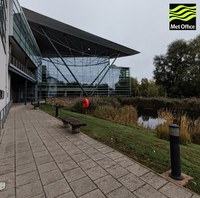STSM with the Land Surface Science Group at the UK Centre for Ecology and Hydrology in Wallingford, UK & the Climate Impacts Group at the Met Office in Exeter, UK
by Athanasios Tsilimigkras
During this STSM, Athanasios had the opportunity to work with well-established land surface modelling experts at the UKCEH and the Met Office, on improving the river routing scheme of the Joint UK Land Environment Simulator (JULES). In its global configuration, JULES uses globally fixed values of river routing parameters which limits its ability to realistically represent short-term river discharge fluctuations. Also, the drainage topology in the current configuration is derived based on the Digital Elevation Map ETOPO5 which is different from the DDM30 riverrouting
network of the ISIMIP protocol – this hinders the systematic multi-model comparison and cross-sectoral climate change impact assessment. The main objective of this STSM was to define a new global configuration of the JULES river routing scheme and adapt the DDM30 river-routing network to increase the consistency of simulations with the ISIMIP protocol.
The STSM resulted in a publicly available branch of the JULES code, where spatially varying routing parameters can be introduced, contrary to the globally fixed set. Simulations of the newly developed river routing configuration showed improved skill in simulating river discharge at the global scale, especially with regard to the temporal response of the routed flow. Also, an additional switch has been implemented in the JULES code, enabling standalone river flow simulation driven solely by runoff input. This helps to considerably reduce simulation time in the case that runoff outputs of long-term simulations are already available.
Athanasios would like to thank Aris Koutroulis, the UKCEH and Douglas Clark, the Met Office, Andrew Hartley and Eleanor Burke as well as the PROCLIAS project for realising this STSM.
If you are interested in doing an STSM, please find more information here.


